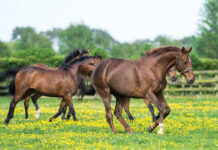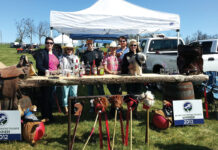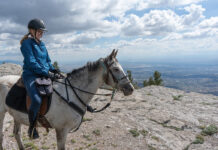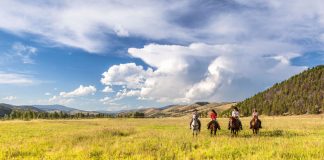When life gets hectic and you just need to get away, what could be a better escape than a camping trip with your horse? No alarms jolting you awake, traffic jams making you late, no phones or emails to answer, and no rushing to business meetings. It’s just the peaceful sounds of nature, a crackling fire and a rippling stream, plus plenty of fresh air and, of course, your horse.
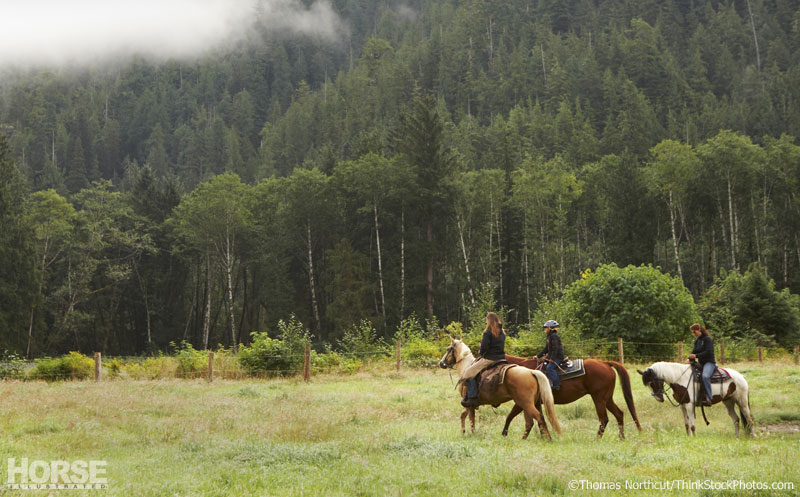
Preparing Your Horse
Although a camping trip may be very relaxing for you, it can be quite strenuous for your horse if he’s not ready for it. Therefore, before you start poring over maps and searching for campgrounds online, determine if your horse is physically and mentally prepared. He needs to be fit enough to meet the demands of long trail rides for consecutive days, especially if you will be venturing into rugged, mountainous terrain. If he is already a veteran trail horse that you ride frequently, you are ahead of the game. If not, you’ve got some training and conditioning to do before your trip.
Your conditioning program will be determined by your horse’s current fitness level and the amount of riding you plan on doing during your camping trip. It may take several months of consistent riding to build your horse’s fitness. Spend as much time in the saddle as you can, and regularly assess his recovery parameters to monitor his improvement. Click here to read more about safely conditioning your horse.
In addition to being physically fit, your horse needs to possess basic skills that are vital to your safety, especially in a remote area. Fortunately, you can build your horse’s fitness level and brush up on his trail skills at the same time.
Here are the skills your horse should possess:
- Halt, stand patiently, back up and leg-yield.
- Negotiate obstacles such as gates, bridges,
brush, logs and water crossings. - Negotiate steep ascents and descents.
Mental preparation is just as important as physical preparation. Your horse needs to be comfortable in unfamiliar surroundings and around other horses. He should accept being tied for long hours to the trailer or an overhead high-line. On the trail, he should tolerate passing and being passed by others, and he must not kick at or intimidate the other horses.
It’s no fun to ride a horse that is behaving badly, and it’s just as unpleasant to ride in the company of one. Build your horse’s confidence by desensitizing him to the many sights, sounds and obstacles he will encounter around camp and on the trail.
Plan Your Trip
Options for equestrian camping are numerous, and an online search will give you a wide variety of results. Once you pick a destination, thoroughly research its facilities and trails.
The amenities offered at equestrian campgrounds vary greatly—from nothing at all (primitive) to electrical and water hookups for RVs and trailers with living quarters. Some may have hitching posts, high-line poles or corrals, and a water source for horses. (If there is water available at the campsite, you should still bring your own and save it for emergencies.)
However, don’t feel like you are limited to designated equestrian campgrounds. If your idea of camping is to really get away from it all, choose a destination that offers open camping. Open camping is great, provided you are completely self-contained, including providing your own water for your horse.
When you’ve selected a destination, inquire as to whether or not the trails are
accessible from the campsite, and if the campground requires advance reservations and/or charges a fee, particularly over a holiday weekend or if your group is large.
Last but not least, as your departure date approaches, check the weather reports for the area and pack accordingly. Click here for a packing list for your horse camping trip.
Your Horse’s Home Away From Home
Even if you have reserved or plan to use a corral provided by the campground, be prepared to use alternate accommodations. You won’t know until you arrive if the corrals are actually usable. You may find another horse in your assigned corral or discover that it is too muddy, or too hot and lacking shade.
You have several options for your horse’s containment. These include overhead ties, portable corrals and electric fencing systems. Which one you choose depends on personal preference, portability and your horse’s temperament.
If your horse will stand tied for extended periods of time without pawing, pacing or fiddling with his rope, buckets or hay bag, then you can tie him to the trailer, a hitching post, an overhead tie arm or a high-line. If you tie your horse to the trailer or a hitching post, the rope should be long enough that he can touch his nose to the ground and reach his feed and water without having any slack in the rope, so he doesn’t get tangled.
If you hang your feed and water buckets on the side of the trailer, take precautions to ensure that your horse can’t get his rope hooked under the buckets or on any part of the trailer, particularly the rear door latches. If you tie more than one horse to the same side of the trailer, they should be far enough apart that they can’t get tangled in one another’s rope.
A safe and easy option is an overhead tie arm attached to your trailer. Horses can move around, lie down and even roll while tied to them. An overhead tie arm (also called a HiTie), which can cost from $300 to $500, is a good investment if you plan on doing a lot of camping.
A more inexpensive option is a high-line strung tightly between two trees, two posts or a combination of both. The best type of rope to use is a 3/4-inch to 1-inch cotton rope, which has a breaking strength of 2,600 to 3,000 pounds. Set your line high enough off the ground that it clears your horse’s head. If you are tying just one horse, you can tie a small loop knot in the center of the rope, or you can tie two knots, with each one at least 6 feet from your end post, and secure your horse between the two knots. You will then attach a carabiner or swivel hook to the rope or loop. If you tie two knots, the hook will slide along the rope, giving your horse some walking room. The knots at each end keep him from walking around the end post or tree. If you will be tying more than one horse to a single high-line, then tie loop knots approximately 10 to 12 feet apart and attach one lead rope to each loop.
When you tie your horse to the line, give him just enough length of rope that he can reach the ground. Put feed, hay and water buckets on the ground. Do not hang a hay bag from the high-line, as your horse’s rope may become tangled in it.
There are several caveats about tying horses: You can’t leave them unattended. If you go for a ride and leave one or more horses behind, have someone stay at the campsite to keep an eye on them. Make hay available at all times. This will alleviate boredom and keep your horse from trying to get morsels of grass that might be out of reach.
If tying your horse isn’t feasible, or is not your preference, consider bringing a portable corral made of steel, aluminum or PVC pipe. However, portable panels require extra space for storage and transportation. People who use them on a regular basis will typically store them in one of their trailer stalls, or on a specially designed rack on the side or top of the trailer.
Portable corral panels made of sturdy steel that are secured using pins or clamps are the safest option, but they are also the most expensive and cumbersome to store and transport. The advantages of this set-up are that it’s relatively secure and sturdy. You can hang feed buckets and hay bags on the panels, and horses have plenty of room to walk around and lie down.
Your other alternative is to set up an enclosure using electric tape or rope, plastic stakes and a battery-operated charger. This type of containment system should only be used with horses that are accustomed to and respect electric fencing. While it’s easy to set up and take down and requires minimal storage space, it’s also the type of enclosure horses most frequently escape from. Additionally, if a horse gets tangled in the electric tape or rope, it usually won’t break, which can result in significant injury.
If you use electric fencing, keep in mind that the only thing between your horse and freedom is your trust that he will respect his boundaries. Give your horse enough room to move around, lie down and even roll without risk of accidentally getting zapped.
Feed and water should be placed in the center of the enclosure to reduce the chance that he will touch the electric tape. Don’t make multiple pens with a single length of electric tape or rope, and don’t put several horses in together if one is dominant. If your horse is prone to pacing, choose another type of containment system.
The Great Escape
Once you arrive at your campsite and get set up, you will have all the time in the world to ride and relax. Take a few moments to review the site’s rules and double-check your maps.
Before you head out on the trail, tidy up your campsite so nothing gets blown around while you’re out riding. Stow your food chests, coolers and horse feed so curious critters can’t get into anything. And when it’s time to pack up and head home, thoroughly clean up your campsite for the next campers.
Camping has always been a great American pastime, and being able to bring your horse only adds to the fun. The time you get to spend bonding with your horse will be well worth themeffort it takes to plan the trip.
More on Camping with Horses:
Horse Camping: Pack it up
New CHA Trail Guide Manual Available
Packing For Your Horse Camping Trip
This article originally appeared in the July 2010 issue of Horse Illustrated. Click here to subscribe.

